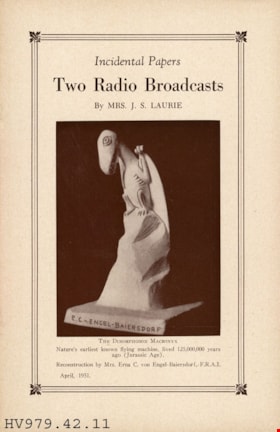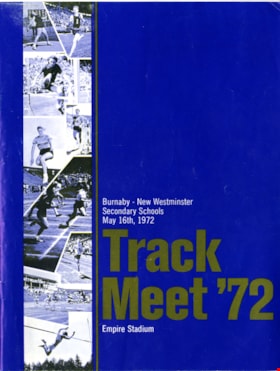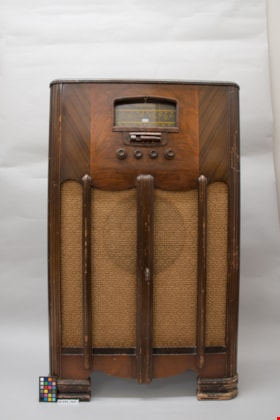booklet
https://search.heritageburnaby.ca/link/museumartifact17361
- Repository
- Burnaby Village Museum
- Accession Code
- HV979.42.11
- Description
- Two Radio Broadcasts - Booklet -- [1951]. Incidental Papers, Two Radio Broadcasts by Mrs. J. S. Laurie. The front cover features a picture of The Dimorphodon Macronyx reconstructed by Erna C. von Engel-Baiersdorf. The booklet was printed in April 1951.
Images
Documents
Program
https://search.heritageburnaby.ca/link/museumartifact90976
- Repository
- Burnaby Village Museum
- Accession Code
- BV020.33.24
- Description
- Burnaby-New Westminster Secondary Schools Track Meet program guide - 1972. Glossy paper cover; 12 pages printed both sides within; bound with two staples at centre. Front cover printed in blue with white and gold lettering and vertical photograph montage to the left; horizontal text to right in white "Burnaby-New Westminster Secondary Schools / May 16th, 1972"; gold coloured oversized text below "Track / Meet '72"; white horizontal text below "Empire Stadium". Back cover printed with yellow background and blue lettering "COLUMBIA SCHOOL / OF BROADCASTING / You're OFF to a Good Start !!! / Congratulations / ... BUT --- Now What ? / COLUMBIA SCHOOL OF BROADCATING / IS OFFERING VARIOUS SCHOLARSHIPS TO / ..." with illustration of a sports broadcaster holding a microphone and runners leaving a starting block.
- Object History
- From Burnaby North Secondary School in 1972.
- Category
- 08. Communication Artifacts
- Classification
- Documentary Artifacts - - Other Documents
- Object Term
- Program
- Colour
- Blue
- Gold
- Black
- White
- Measurements
- 28 cm high x 21 cm wide
Images
radio
https://search.heritageburnaby.ca/link/museumartifact7102
- Repository
- Burnaby Village Museum
- Accession Code
- BV985.399.1
- Description
- Cabinet style radio is a Stromberg - Carlson, Model No. 972, produced ca. 1940. It can receive standard broadcast and shortwave transmissions. It is also possible to plug in an electronic phonograph to have it play through the radio. There are six push buttons on the front that allow the user to preset stations for quick tuning. . Two of the stations, KOMO and KIRO, broadcast from Seattle, Washington and stations CJOR, CKWX, CKMO broadcast from Vancouver. There is also a CBR station which is the Citizens Band radio. Glued inside the radio cabinet is an envelope that contains a manual, "INSTALLATION AND OPERATING INSTRUCTIONS / FOR STROMBERG-CARLSON NO. 972 RADIO RECEIVERS" and a warranty card "Stromberg-Carlson / Stromberg-Carlson Telephone Mfg. Co. of Canada Limited/ 211-219 Geary Ave. / Warranty Registry Department Toronto 4, Canada". There is also an envelope with three cards stapled together that have punch out radio station call letters. one for "CANADIAN STATIONS" and two for "AMERICAN STATIONS".
- Object History
- Originally founded in 1894 to manufacture telephones, the Stromberg-Carlson company also produced radio components, and began selling their own complete sets during the early 1920s. By that time, the radio craze had fully absorbed the American public, and radio pioneer RCA was cornering the market after scooping up over 2,000 broadcasting-related patents. Stromberg-Carlson entered the field by making smaller parts for tube radios. Eventually, the company applied its telephone-audio expertise to develop a successful line of radio headsets. In 1923, the company was licensed to produce the “Neutodyne” radio circuit designed by Dr. L. A. Hazeltine. Stromberg-Carlson’s first set came out in early 1924, and the company steadily grew its radio production, eventually requiring RCA licenses for several products. In 1926, Stromberg-Carlson became the first manufacturer to merge phonograph and radio technology by incorporating a phonograph jack into its radio chassis. By the end of the decade, Stromberg-Carlson sold sets with fully integrated radio and turntable technologies, and the company’s radio sales surpassed that of its telephones... The 1930s represented boom years for Stromberg-Carlson’s radio development, as it introduced new modifications like automatic volume control, improved amplifying methods, and an early push-button tuning mechanism. Ads from the late '30s emphasize other innovations, like the unique Stromberg-Carlson “acoustical labyrinth,” a complex baffle design which improved sound quality by guiding audio waves through a series of interlocking chambers, and its “Te-Lek-Tor” series, which included remote-control capabilities. “Let your dealer arrange an audition,” was the brand’s cheeky slogan, emphasizing its reputation for superior sound quality. Over the next 20 years, Stromberg-Carlson created an array of gorgeous Art Deco-inspired radios, from the sleek, ivory-colored 140-K console to the tabletop 225-H with its floral-patterned speaker grill and octagonal dial. After the company’s merger with General Dynamics in 1955, the business was restructured to focus production on telephone products, and its radios were discontinued.
- Reference
- http://www.collectorsweekly.com/radios/stromberg
- Country Made
- United States of America
- Canada
- Province Made
- Ontario
- Site/City Made
- Toronto



